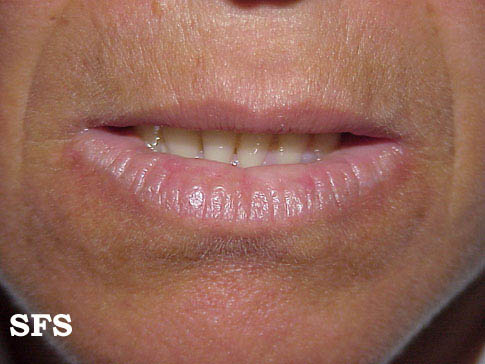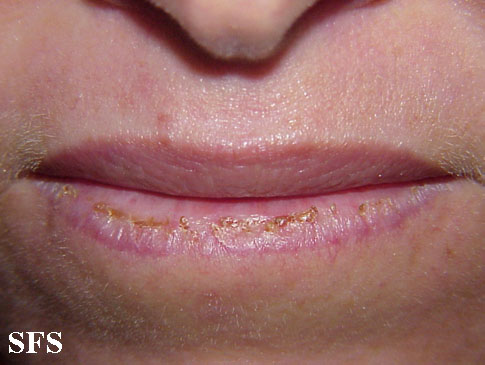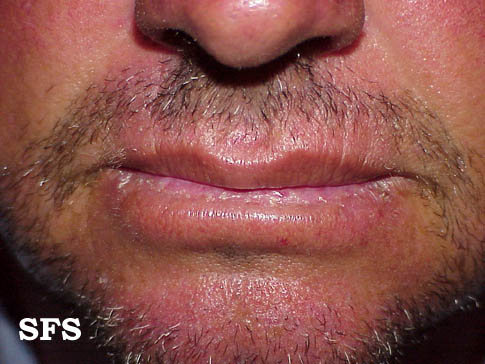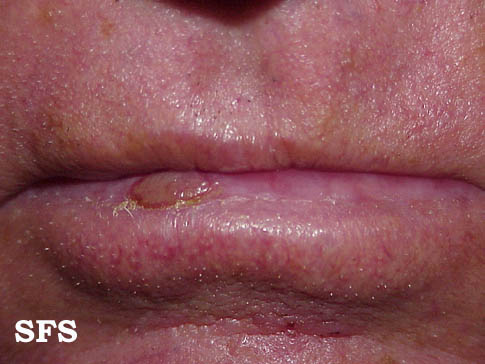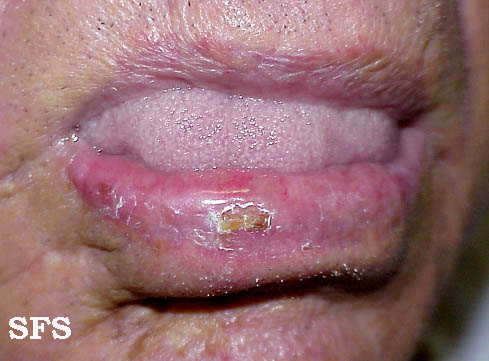Actinic cheilitis
|
WikiDoc Resources for Actinic cheilitis |
|
Articles |
|---|
|
Most recent articles on Actinic cheilitis Most cited articles on Actinic cheilitis |
|
Media |
|
Powerpoint slides on Actinic cheilitis |
|
Evidence Based Medicine |
|
Cochrane Collaboration on Actinic cheilitis |
|
Clinical Trials |
|
Ongoing Trials on Actinic cheilitis at Clinical Trials.gov Trial results on Actinic cheilitis Clinical Trials on Actinic cheilitis at Google
|
|
Guidelines / Policies / Govt |
|
US National Guidelines Clearinghouse on Actinic cheilitis NICE Guidance on Actinic cheilitis
|
|
Books |
|
News |
|
Commentary |
|
Definitions |
|
Patient Resources / Community |
|
Patient resources on Actinic cheilitis Discussion groups on Actinic cheilitis Patient Handouts on Actinic cheilitis Directions to Hospitals Treating Actinic cheilitis Risk calculators and risk factors for Actinic cheilitis
|
|
Healthcare Provider Resources |
|
Causes & Risk Factors for Actinic cheilitis |
|
Continuing Medical Education (CME) |
|
International |
|
|
|
Business |
|
Experimental / Informatics |
Editor-In-Chief: C. Michael Gibson, M.S., M.D. [1]; Associate Editor(s)-in-Chief: Jesus Rosario Hernandez, M.D. [2].
Synonyms and keywords: Solar cheilitis, actinic cheilosis.
Overview
Actinic cheilitis (also known as "actinic cheilosis",[1] "sailor's lip"),[2] is a form of cheilitis which is the counterpart of actinic keratosis of the skin and can develop into squamous cell carcinoma. In actinic cheilitis, there is thickening whitish discoloration of the lip at the border of the lip and skin. There is also a loss of the usually sharp border between the red of the lip and the normal skin, known as the vermillion border. The lip may become scaly and indurated as actinic cheilitis progresses. The lesion is usually painless, persistent, more common in older males, and more common in individuals with a light complexion with a history of chronic sun exposure.
Causes
Actinic cheilitis is caused by chronic and excessive exposure to ultraviolet radiation in sunlight. Additional factors may also play a role, including tobacco use, lip irritation, poor oral hygiene, and ill-fitting dentures.[3]
Treatment options
This condition is considered premalignant because it may lead to squamous cell carcinoma in about 10% of all cases. It is not possible to predict which cases will progress into SCC, so the current consensus is that all lesions should be treated.[4]
Treatment options include 5-fluorouracil, imiquimod, scalpel vermillionectomy, chemical peel, electrosurgery, and carbon dioxide laser vaporization. These curative treatments attempt to destroy or remove the damaged epithelium. All methods are associated with some degree of pain, edema, and a relatively low rate of recurrence.
Medication
Topical 5-fluorouracil (5-FU, Efudex, Carac) has been shown to be an effective therapy for diffuse, but minor actinic cheilitis. 5-fluorouracil works by blocking DNA synthesis. Cells that are rapidly growing need more DNA, so they accumulate more 5-fluorouracil, resulting in their death. Normal skin is much less affected. The treatment usually takes 2–4 weeks depending on the response. The typical response includes an inflammatory phase, followed by redness, burning, oozing, and finally erosion. Treatment is stopped when ulceration and crusting appear. There is minimal scarring. Complete clearance has been reported in about 50% of patients.[5]
Imiquimod (Aldara) is an immune response modifier that has been studied for the treatment of actinic cheilitis. It promotes an immune response in the skin leading to apoptosis (death) of the tumor cells. It causes the epidermis to be invaded by macrophages, which leads to epidermal erosion. T-cells are also activated as a result of imiquimod treatment. Imiquimod appears to promote an “immune memory” that reduces the recurrence of lesions. There is minimal scarring. Complete clearance has been demonstrated in up to 45% of patients with actinic keratoses. However, the dose and duration of therapy, as well as the long-term efficacy, still need to be established in the treatment of actinic cheilitis.[6]
Procedures
Both cryosurgery and electrosurgery are effective choices for small areas of actinic cheilitis. Cryosurgery is accomplished by applying liquid nitrogen in an open spraying technique. Local anesthesia is not required, but treatment of the entire lip can be quite painful. Cure rates in excess of 96% have been reported. Cryosurgery is the treatment of choice for focal areas of actinic cheilitis. Electrosurgery is an alternate treatment, but local anesthesia is required, making it less practical than cryosurgery. With both techniques, adjacent tissue damage can delay healing and promote scar formation.[3]
More extensive or recurring areas of actinic cheilitis may be treated with either a shave vermillionectomy or a carbon dioxide laser. The shave vemillionectomy removes a portion of the vermillion ridge but leaves the underlying muscle intact. Considerable bleeding can occur during the procedure due to the vascular nature of the lip. A linear scar may also form after treatment, but this can usually be minimized with massage and steroids. Healing time is short, and effectiveness is very high.[3]
A newer procedure uses a carbon dioxide laser to ablate the vermillion border. This treatment is relatively quick and easy to perform, but it requires a skilled operator. Anesthesia is usually required. Secondary infection and scarring can occur with laser ablation. In most cases, the scar is minimal, and responds well to steroids. Pain can be a progressive problem during the healing phase, which can last three weeks or more. However, the carbon dioxide laser also offers a very high success rate, with very few recurrences.[3]
Chemical peeling with 50% trichloroacetic acid has also been evaluated, but results have been poor. Healing usually takes 7–10 days with very few side effects. However, limited studies show that the success rate may be lower than 30%.[3]
Physical examination
Gallery
References
- ↑ Rapini, Ronald P.; Bolognia, Jean L.; Jorizzo, Joseph L. (2007). Dermatology: 2-Volume Set. St. Louis: Mosby. ISBN 1-4160-2999-0.
- ↑ Treister NS, Bruch JM (2010). Clinical oral medicine and pathology. New York: Humana Press. p. 121. ISBN 978-1-60327-519-4.
- ↑ 3.0 3.1 3.2 3.3 3.4 Dufresne, Raymond; Curlin (1997). "Actinic Cheilitis. A Treatment Review". Dermatologic Surgery. 23 (1): 15–21. doi:10.1016/S1076-0512(97)00010-1. PMID 9107289.
- ↑ Brian Berman, MD, PhD n Leah Bienstock, PA-C n Louis Kuritzky, MD E.J. Mayeaux, Jr, MD, DABFP, FAAFP n Stephen K. Tyring, MD, PhD, MBA (2007). "Actinic Keratoses: Sequelae and Treatments" (PDF). Journal of Family Practice. Retrieved 2008-10-16.
- ↑ Richard A. Helms, Eric T. Herfindal, David J. Quan, Dick R. Gourley (2006). Textbook of Therapeutics: Drug and Disease Management. Lippincott Williams & Wilkins. p. 223. ISBN 0-7817-5734-7.
- ↑ Larios, George; Alevizos (2007). "Recognition and treatment of actinic cheilitis". American Family Physician. 77 (8): 1078–9. PMID 18481555. Retrieved 2008-10-16.[dead link]
